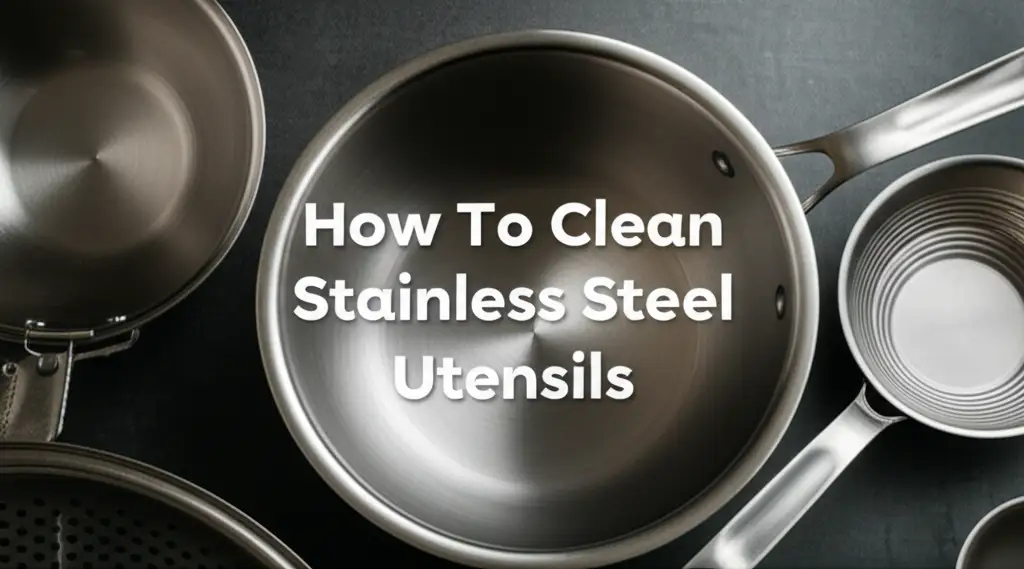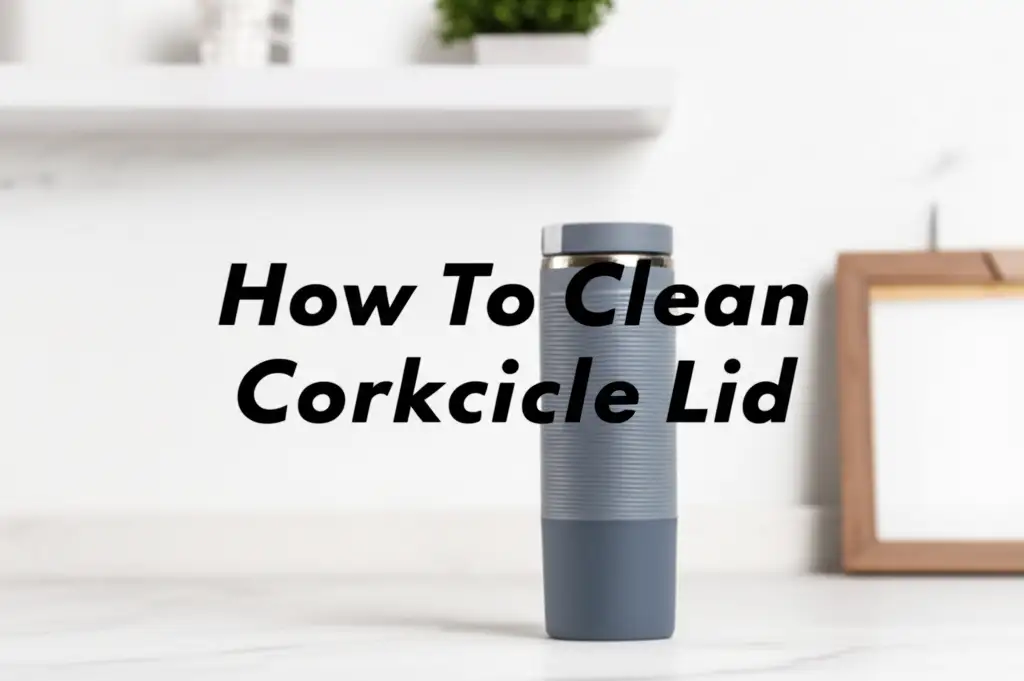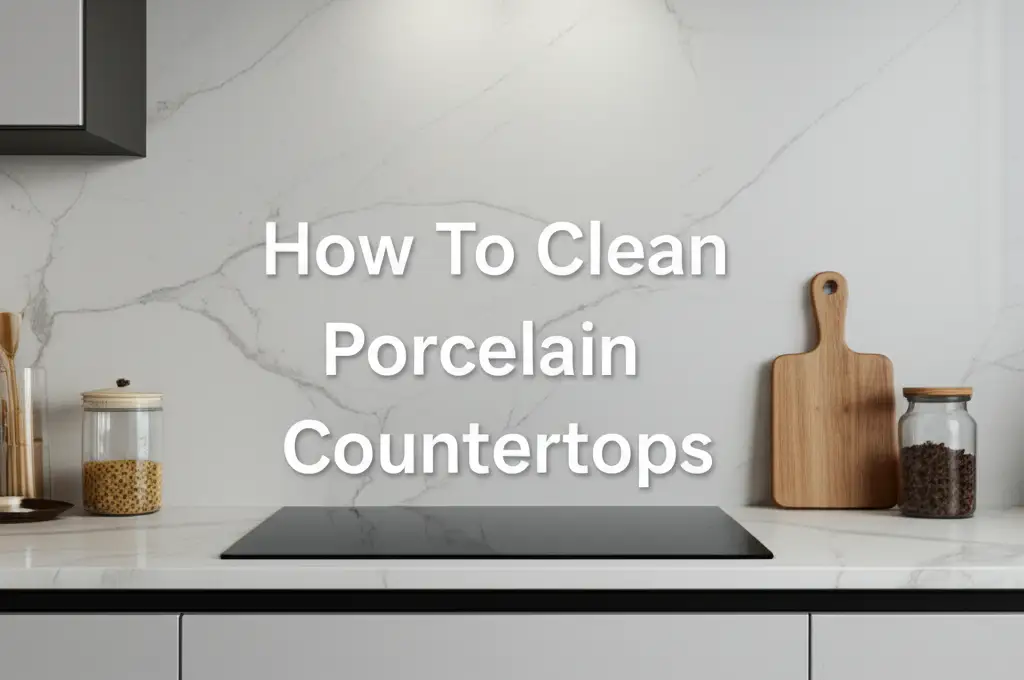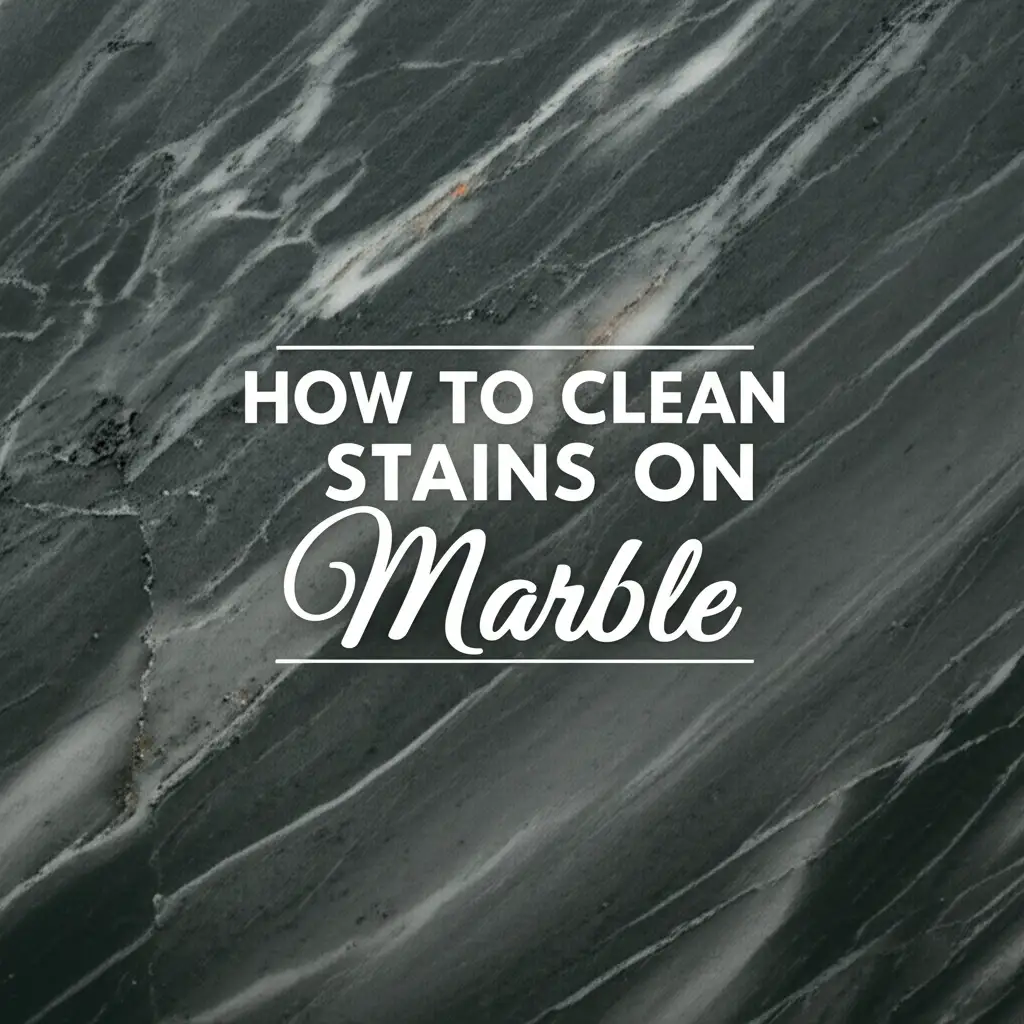· Home Care · 16 min read
How To Clean Stainless Steel Utensils

How to Easily Clean Stainless Steel Utensils for a Brilliant Shine
Stainless steel utensils are kitchen essentials. We use them every day for cooking and eating. Their durable nature makes them a top choice for homes. However, even these sturdy items can lose their sparkle. They can get water spots, food residue, or discoloration. Learning how to clean stainless steel utensils keeps them looking new. This guide will show you simple ways to restore their shine. We will cover daily care, stain removal, and polishing techniques.
Takeaway:
- Clean utensils promptly after use to prevent stains.
- Use gentle methods like dish soap or natural cleaners for everyday grime.
- Tackle tough issues like rust or burnt food with targeted solutions.
- Regular polishing helps maintain the brilliant shine of your flatware.
To clean stainless steel utensils effectively, wash them with warm, soapy water after each use. For stubborn marks, apply a paste of baking soda and water, then gently scrub. Rinse thoroughly and dry immediately with a soft cloth to prevent water spots and keep them shining.
Understanding Stainless Steel Utensils: Why They Need Care
Stainless steel is an alloy. It contains iron, chromium, and other elements. Chromium forms a passive layer on the surface. This layer helps resist rust and corrosion. This makes stainless steel a popular material for utensils.
However, this layer is not invincible. Food acids, harsh detergents, or hard water can damage it. Scratches also break the protective film. Over time, utensils can develop dullness, water spots, or even light rust. Knowing these issues helps you care for your items better. Proper cleaning extends their lifespan.
Utensils endure heavy daily use. They contact many food types. This leads to common problems. Water spots often appear from mineral deposits in tap water. Food residue can dry and harden, creating stubborn marks. Heat exposure might cause discoloration or rainbow stains. These common issues require specific cleaning methods. You can learn more about general stain removal for stainless steel here. Understanding the problem helps you choose the right cleaning solution.
Daily Cleaning Rituals for Stainless Steel Utensils
Keeping your stainless steel utensils clean daily is easy. Prompt cleaning prevents most stains. You can choose between hand washing or using a dishwasher. Both methods are effective when done correctly. Regular care maintains their beautiful appearance.
Hand Washing for Best Results
Hand washing offers the most gentle approach. It helps prevent scratches and dullness. I often prefer this method for my favorite pieces. Use warm water and mild dish soap.
- Rinse Immediately: Rinse utensils right after use. This removes loose food particles. It stops food from drying and sticking.
- Wash with Soft Sponge: Use a soft cloth or sponge. Avoid abrasive scrubbers. They can scratch the surface. Gently scrub each utensil with soapy water.
- Rinse Thoroughly: Rinse under clean, running water. Ensure all soap residue is gone. Soap can leave streaks if not fully removed.
- Dry Immediately: This is a crucial step. Use a clean, dry microfiber cloth. Drying prevents water spots and streaks. Air drying often leaves mineral deposits behind.
Dishwasher Use for Convenience
Most stainless steel utensils are dishwasher safe. This offers a convenient cleaning option. Follow a few simple rules for best results. It saves time and effort.
- Load Properly: Place utensils with handles down. Mix forks, spoons, and knives. This prevents nesting and ensures thorough cleaning. Make sure nothing blocks the spray arms.
- Use Mild Detergent: Choose a mild dishwasher detergent. Avoid detergents with harsh chemicals or chlorine bleach. These can harm the stainless steel finish over time.
- Use Rinse Aid: A rinse aid helps water bead off surfaces. This minimizes water spots. It promotes faster drying and a shinier finish.
- Remove Promptly: Unload the dishwasher soon after the cycle finishes. This prevents steam and heat from causing water spots. Give them a quick hand dry if any moisture remains.
Natural Remedies: Cleaning Stainless Steel Utensils with Household Items
You do not always need harsh chemicals to clean stainless steel utensils. Many common household items work wonders. These natural solutions are safe and effective. They are also gentle on your utensils and the environment. I often reach for these simple ingredients first.
White Vinegar for Shine and Water Spots
White vinegar is a natural disinfectant and powerful cleaner. Its mild acidity dissolves mineral deposits. It works great on water spots and dullness. You can use it in a few ways. For general cleaning, mix equal parts white vinegar and water.
- Spray and Wipe: Spray the solution onto your utensils. Let it sit for a minute. Wipe with a clean, soft cloth. Then buff dry.
- Soak for Tough Spots: For stubborn water spots, soak utensils in undiluted white vinegar for a few minutes. Rinse well. Dry immediately. This method is very effective for hard water stains, similar to how you would clean a stainless steel sink with hard water marks. Vinegar leaves a streak-free shine. You can learn more about cleaning stainless steel appliances with vinegar here.
Baking Soda for Gentle Abrasion and Stains
Baking soda is a mild abrasive and odor absorber. It helps remove tough stains without scratching. It forms a gentle scrubbing paste. This paste lifts grime and food residue.
- Create a Paste: Mix baking soda with a little water. Form a thick paste. The consistency should be like toothpaste.
- Apply and Scrub: Apply the paste to stained areas. Use a soft cloth or non-abrasive sponge. Gently rub in the direction of the grain.
- Rinse and Dry: Rinse thoroughly with water. Ensure all baking soda is gone. Dry immediately with a clean towel. Baking soda is excellent for burnt-on food, much like it is used to clean stainless steel pans with baking soda.
Lemon Juice for Brightening
Lemon juice offers natural acidity. It can help cut through grease and add shine. It also leaves a fresh scent. This method is good for general brightening.
- Squeeze and Wipe: Squeeze fresh lemon juice onto a soft cloth. Wipe down your utensils.
- Buff to Shine: Buff the utensils with a dry microfiber cloth. This brings out their natural luster. For very dull items, you can mix lemon juice with a little salt for a slightly more abrasive scrub. Remember to rinse very well after using any acidic solution.
Tackling Stubborn Stains: Water Spots and Discoloration
Even with regular cleaning, stainless steel utensils can develop stubborn stains. Water spots are very common. They appear as cloudy marks. Discoloration, like rainbow stains or heat tint, can also happen. These issues need a bit more effort. Do not worry; they are fixable with the right approach.
Eliminating Hard Water Spots
Hard water contains minerals like calcium and magnesium. When water dries, these minerals stay behind. They leave white, chalky spots. These spots look unsightly. They are also tough to remove with just soap and water.
- Vinegar Soak: Fill a bowl with white vinegar. Submerge your utensils with water spots. Let them soak for 15-30 minutes. The vinegar dissolves the mineral deposits.
- Gentle Scrub and Dry: Remove utensils from the vinegar. Use a soft brush or cloth to gently scrub away any remaining residue. Rinse thoroughly with clean water. Immediately dry with a streak-free microfiber cloth. This step is crucial. This method works well for any tea stains on stainless steel as well.
Addressing Rainbow Stains and Heat Tint
Rainbow stains, also known as heat tint, are colorful discolorations. They usually appear from high heat exposure. This can happen during cooking or from very hot dishwasher cycles. It is a thin oxide layer. It does not harm the utensil, but it looks unappealing.
- Baking Soda Paste: Mix baking soda with a small amount of water. Create a thick paste. This paste is mildly abrasive.
- Apply and Rub: Apply the paste directly to the rainbow stain. Use a soft cloth or sponge. Gently rub in the direction of the metal grain. Rubbing with the grain helps prevent tiny scratches.
- Rinse and Buff: Rinse the utensil completely. Ensure all baking soda is removed. Buff dry with a clean, dry cloth. The stain should diminish or disappear. Repeat if necessary for severe discoloration.
Dealing with General Discoloration
Sometimes utensils just look dull or tarnished. This general discoloration is often due to accumulated residue or aging. It makes them look less inviting. A good cleaning can refresh them.
- Lemon and Salt Paste: Cut a lemon in half. Dip the cut side into a small pile of fine salt. The salt acts as a gentle abrasive. The lemon provides acid.
- Rub and Rinse: Use the lemon half to gently rub the discolored areas. Rub in small circles. Rinse the utensil thoroughly with warm water.
- Polish: Dry immediately with a clean cloth. Then, use a small amount of olive oil or mineral oil on a paper towel. Rub it onto the utensil. Buff it to a brilliant shine. This helps restore the luster.
Removing Tough Foes: Burnt Food and Grease from Utensils
Stainless steel utensils, especially spoons or spatulas, can get burnt food or grease stuck on them. This happens easily during cooking. Burnt-on residue or sticky grease can be very tough to remove. Regular washing often does not work. But, with the right techniques, you can make them clean again. I have faced this many times in my kitchen.
Tackling Burnt Food Residue
Burnt food sticks hard to surfaces. It forms a carbonized layer. This layer needs to be softened before removal. Do not use harsh metal scrubbers. They can scratch your utensils permanently.
- Soak in Hot Soapy Water: Fill a bowl with very hot water and a good amount of dish soap. Submerge the utensils with burnt food. Let them soak for several hours or overnight. This softens the burnt bits. This soaking method is effective for any burnt stainless steel pot or pan.
- Baking Soda Scrub: After soaking, drain the water. Make a paste with baking soda and a little water. Apply this paste generously over the burnt areas. Use a non-abrasive scrubber, like a plastic scraper or a nylon brush. Gently scrape and rub the burnt residue away. This process is similar to how you would clean burnt oil from a stainless steel pan.
- Boil with Vinegar (Optional): For very stubborn burnt marks, you can gently boil the utensils. Place them in a pot. Cover them with water and add a splash of white vinegar. Bring to a gentle boil for 10-15 minutes. Let cool. Then proceed with the baking soda scrub.
Cleaning Grease and Oily Film
Grease and oil can leave a sticky, dull film on utensils. This film attracts more dirt. It also makes your utensils feel unpleasant to touch. Standard dish soap helps, but sometimes you need extra power.
- Hot Water and Dish Soap: Start with the basics. Use very hot water. Add a generous amount of liquid dish soap. The hot water helps loosen the grease. The soap breaks down the oil.
- Degreaser or Lemon Juice: For extra greasy utensils, consider a degreasing dish soap. Alternatively, a natural option is lemon juice. Squeeze lemon juice directly onto the greasy areas. Let it sit for a few minutes. The acid in the lemon juice cuts through grease. This is a great tip for cleaning grease off stainless steel appliances too.
- Wipe with Microfiber: Use a clean microfiber cloth. Wipe away the grease and soap mixture. Microfiber excels at picking up oily residues. Rinse thoroughly with clean water. Dry immediately to prevent new water spots. Repeat if necessary for a completely clean finish.
Conquering Rust Spots on Stainless Steel Utensils
Rust on stainless steel utensils might seem surprising. Stainless steel means “stain less,” not “stain never.” Rust can still appear. This usually happens from prolonged contact with iron, standing water, or certain chemicals. Do not panic if you see small orange or brown spots. You can remove them.
Why Rust Appears
Rust on stainless steel is often surface rust. It comes from external sources. For example, leaving stainless steel in a sink with cast iron pans can transfer rust. Sometimes, tiny particles from steel wool can embed in the surface and rust. Hard water can also contribute. Proper care helps prevent this.
Gentle Rust Removal Methods
Never use abrasive pads or steel wool on rusted stainless steel. These can create more damage. They can also scratch the protective layer. Always aim for gentle cleaning.
- Lemon Juice and Salt: This is a fantastic natural rust remover. Cut a lemon in half. Sprinkle a small amount of fine salt onto the rusty spot. Use the lemon half to gently rub the salt into the rust. The lemon juice dissolves the rust. The salt provides a gentle scrub.
- Baking Soda Paste: Mix baking soda with a little water to make a paste. Apply the paste generously over the rust spot. Let it sit for about an hour. This allows the baking soda to work on the rust. Then, use a soft toothbrush or non-abrasive pad to gently scrub. The rust should lift away.
- White Vinegar Soak: For more widespread rust spots, soak the entire utensil. Place the utensil in a bowl of white vinegar. Let it soak for several hours or even overnight. The vinegar’s acidity breaks down the rust. After soaking, gently wipe the rust away with a soft cloth. This method is highly effective for rust removal from stainless steel.
- Oxalic Acid (Bar Keepers Friend): For stubborn rust, a product containing oxalic acid can work wonders. Bar Keepers Friend is a popular choice. Dampen the utensil. Sprinkle a small amount of the powder onto the rust. Use a wet, soft cloth to gently rub in the direction of the grain. Rinse thoroughly. This product is very effective, but always test it in an inconspicuous area first.
Post-Rust Removal Care
After removing rust, always rinse the utensil thoroughly. Remove all cleaning product residue. Then, dry the utensil immediately and completely. This prevents new water spots or rust from forming. A light application of mineral oil can also help protect the surface.
Polishing and Maintaining the Luster of Your Utensils
Cleaning stainless steel utensils removes dirt and stains. Polishing brings back their brilliant shine. Regular maintenance ensures they stay beautiful. These steps are easy to do and make a big difference. I always take time to polish my utensils after cleaning.
Restoring Shine with Polishing
Even clean utensils can look dull. Polishing makes them sparkle. It also helps buff out minor imperfections. This step is important for presentation.
- Choose a Polishing Agent: You have several options.
- Olive Oil or Mineral Oil: Put a few drops of olive oil or mineral oil on a clean, dry microfiber cloth. This is my go-to choice.
- Stainless Steel Cleaner/Polish: Commercial stainless steel polishes are also available. Follow the product instructions carefully. They are designed to protect and shine.
- Apply and Buff: Apply the chosen agent to the utensil. Rub in the direction of the metal grain. Use firm, even strokes. The oil will create a thin, protective layer. It repels fingerprints and water spots. This helps keep your utensils looking clean. Continue buffing until you achieve a high shine. Ensure no oily residue remains.
- Wipe Away Excess: Use a separate clean, dry part of the cloth to wipe away any excess oil. You want a thin, even coat, not a greasy feel. Your utensils will look like new.
Long-Term Maintenance Tips
Prevention is key to keeping your stainless steel utensils in top condition. Simple habits can extend their life and shine. I follow these rules consistently.
- Dry Immediately After Washing: This is the most important step. Water, especially hard water, leaves spots. Drying prevents these mineral deposits. Use a soft, lint-free towel.
- Avoid Abrasive Cleaners and Tools: Never use steel wool, abrasive scouring pads, or harsh chemical cleaners. These can scratch the surface. They break the passive layer. This makes the steel more prone to stains and rust. Use soft cloths, sponges, or nylon brushes only.
- Store Properly: Store utensils in a dry drawer or container. Avoid storing them wet. Separate them from other metals that might cause scratches or transfer rust. For example, keep them away from cast iron or carbon steel items.
- Regular Deep Cleaning: Plan for a deep cleaning session once a month. This involves soaking and thorough cleaning. It removes any buildup you might miss during daily washing. This keeps them looking their best over time.
FAQ Section
How often should I clean stainless steel utensils? Clean stainless steel utensils after every use. This prevents food from drying onto the surface. It also avoids water spots and discoloration. A quick wash and immediate drying are usually enough for daily care. Deep cleaning or polishing can be done as needed, perhaps once a month, to maintain their luster.
Can I put stainless steel utensils in the dishwasher? Yes, most stainless steel utensils are dishwasher safe. However, remove them promptly after the cycle finishes. This prevents water spots caused by steam or prolonged exposure to moisture. Use a mild detergent and a rinse aid for best results. Always dry them by hand if any water remains.
What causes rainbow stains on stainless steel utensils? Rainbow stains, or heat tint, occur from high heat exposure. This can happen during cooking or in the dishwasher. The heat causes a thin oxide layer to form on the surface. This layer refracts light, creating a rainbow effect. You can remove these stains with a baking soda paste and gentle scrubbing.
Is it safe to use abrasive cleaners on stainless steel? No, it is not safe to use abrasive cleaners or tools like steel wool on stainless steel utensils. Abrasives can scratch the surface. This damages the protective chromium oxide layer. Scratches make the stainless steel more prone to rust and permanent damage. Always use soft cloths or non-abrasive pads.
How do I prevent water spots on my utensils? To prevent water spots, always dry your stainless steel utensils immediately after washing. Use a clean, lint-free microfiber cloth. If using a dishwasher, use a rinse aid and remove utensils promptly. Hard water is the main culprit, so immediate drying is your best defense against these mineral deposits.
Conclusion
Keeping your stainless steel utensils looking their best is not hard. These items are a significant part of our kitchens. They deserve good care. By following these simple cleaning and maintenance steps, you ensure their lasting beauty. From daily washes to tackling tough stains, you now have the knowledge.
Remember to dry your utensils immediately after cleaning. This one step makes a big difference in preventing spots. Embrace the power of natural cleaners like vinegar and baking soda. They are effective and gentle. Regular polishing also keeps that mirror-like shine. Your stainless steel utensils will serve you well for many years. Start applying these tips today to clean stainless steel utensils effectively and enjoy their brilliant shine.
- stainless steel cleaning
- utensil care
- kitchen cleaning
- remove stains
- polish stainless steel




